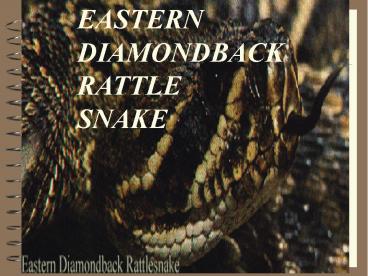EASTERN DIAMONDBACK RATTLE SNAKE - PowerPoint PPT Presentation
Title:
EASTERN DIAMONDBACK RATTLE SNAKE
Description:
BEHAVIOR OF SNAKES ... the two snakes stood nose to nose. ... Depending on the species, snakes. maybe egg-layers or give birth to live. young. ... – PowerPoint PPT presentation
Number of Views:310
Avg rating:3.0/5.0
Title: EASTERN DIAMONDBACK RATTLE SNAKE
1
EASTERN DIAMONDBACK RATTLESNAKE
2
Class Reptilia, Order Squamata, Family
Viperidae, Genus species Crotalus adamanteus.
3
SIZELength averages between 2.5 and 6 feet with
record length 8 feet. With a triangular shaped
head with bones of jaw loosely connected so that
snake can swallow animals larger than its head
4
Habitats Coastal lowlands of southeast US
including North and South Carolina, Georgia,
Florida and eastern Louisiana. Also in the
palmetto flatwoods, pinelands and sand hills.
Sometimes enters salt water and swims to Florida
Keys.
5
BEHAVIOR OF SNAKESThe two male diamondbacks
initiated a behavior pattern sometimes refered to
as a "combat dance". "the two snakes stood nose
to nose. They turned their heads sideways to each
other, and then, strangely, turned their heads so
that they faced in opposite directions.
6
Diet The diamond feed on different rabbits,
rodents and birds.
7
REPRODUCTIONUsually a dozen eggs are laid in
rotting logs or stumps. The eggs are smooth,
shiny and elongate in shape. They are laid in
late June or July and hatch at 7-8 inches in late
August of September. Newborns are grayish green.
8
Most females do not reproduce until they are nine
years old. In addition to delayed sexual
maturity, another factor that Contributes to
their relatively low reproductive potential is
that most females only reproduce every three
years.
9
ReproductionDepending on the species,
snakesmaybe egg-layers or give birth to live
young. They generally mate in the spring, or are
born in late summer.
10
ReproductionEgg-layers usually deposit their
clutches in dirt, beneath stones or logs, or in
piles of decaying wood.
11
Snake tracks can be wavy or straight lines. They
are usually furrows in the ground that can be 1/2
or more wide.
12
HOW MANY ARE LEFTNot formally listed, but is
considered Endangered in North and South
Carolina. Its numbers have been reduced
considerably by hunting and development of the
land.
13
1.http//www.gwf.org/library/ani_diamon.htm
2.http//www.csc.noaa.gov/otter/htmls/project/dbac
k.htm 3.www.umass.edu/umext/snake/info
14
(No Transcript)

